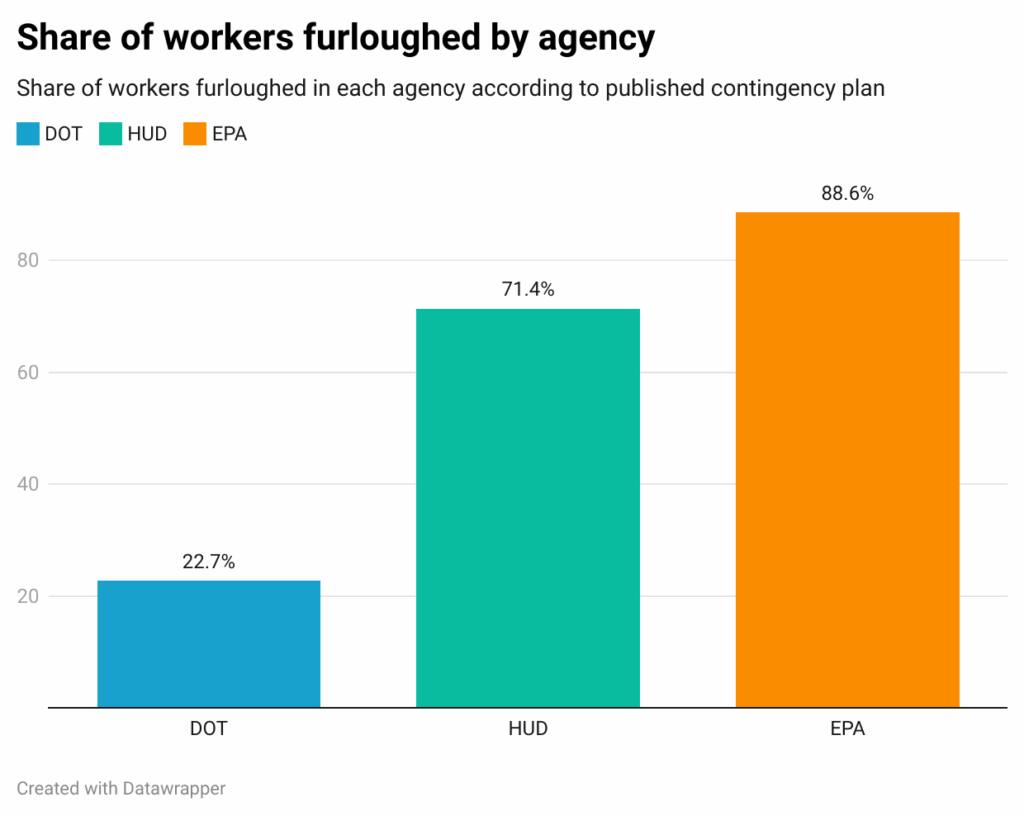
News
By Kennedy O'Dell, October 23, 2025
The federal government is three weeks into a shutdown, and massive swaths of the federal government are frozen, the majority of its workers furloughed, while the Trump administration pursues targeted and explicitly partisan firings to exert political pressure on Democrats to vote on a Republican-preferred funding bill. There’s no end in sight, and pain abounds as an increasing range of activities, from air travel to home sales, become mired in the fallout.
On October 1st, the federal government shut down after Congress failed to pass a seven-week government funding extension led by Congressional Republicans. The unsuccessful funding measure had passed the Republican-controlled House but has since failed 12 times in the Senate, where it requires 60 votes—and thus the support of Democrats—to pass. In the days since the government shutdown, federal workers have been furloughed, some programs have lapsed, and much of the federal government’s work, from processing grants to reviewing projects for compliance with federal guidelines, has ground to a halt. On top of the more standard shutdown protocols, the Trump administration has announced an unprecedented, and explicitly politically motivated, round of firings to punish Democrats for the shutdown. This maelstrom created by the reductions in force (RIFs), furloughs, and other side effects of the shutdown seems likely to rage on to the detriment of communities across the country—but how is it affecting key smart growth programs and how might it ultimately resolve?
Reductions in force
In the first two weeks of the shutdown, the Trump administration announced a round of firings of federal workers explicitly tied to the government shutdown. The Department of Housing and Urban Development issued reduction in force (RIF) notices to over 400 employees, including staff in Community Planning and Development, Public and Indian Housing, Housing Counseling, Fair Housing and Equal Opportunity, and broader HUD operations. Among those fired were inspectors who help verify the quality and safety of housing that receives federal support, as well as staff who distribute funding to support affordable housing. The Department of Transportation appears to have been spared in the first round of RIFs, but there is no guarantee that later RIFs will not include some DOT staff. Early information on the few dozen employees impacted by the RIFs at EPA was more fleeting, with EPA failing to provide concrete information on how many workers at the agency received notices or which offices are seeing reductions.
Following an initial attempt to attack it in March, the administration eliminated all staff at the Treasury Department’s Community Development Financial Institutions Fund (CDFI Fund). The CDFI Fund supports the growth and capacity of a nationwide network of lenders, investors, and financial service providers who, in turn, provide affordable credit, capital, and financial services for the communities they operate in, with a particular focus on under-resourced rural and urban areas. The CDFI Fund provides capital infusions and technical assistance to individual Community Development Financial Institutions (CDFIs), which then use that capital to provide business and homeownership loans, invest in the creation or preservation of affordable homes, and provide financing for the creation of needed community assets such as childcare and healthcare centers. Bipartisan members of Congress, including Senate Community Development Finance Caucus co-chairs Senator Mike Crapo (R-Idaho) and Senator Mark Warner (D-Virginia), expressed support for the CDFI Fund in the immediate wake of the announcement, with the bipartisan pair of co-chairs committing to take joint action to attempt to resolve the situation. Senator Warner has said he believes the action is illegal and that he and his co-chair did not see the RIFs coming. Last Friday, Politico also reported that senior Republicans in Congress were also circulating a letter to the Trump administration, implicitly asking for a reversal of the decision and the rehiring of the fired CDFI Fund employees.
While some Republican members of Congress have criticized the firings, the announcements have stood—although a recent court ruling has led to uncertainty about the future of the impacted workers. The American Federation of Government Employees filed suit against the Trump administration to pause the firings in California District Court, and last Wednesday, a judge issued a decision blocking the administration from firing federal workers represented by the American Federation of Government Employees during the shutdown on the grounds that the firings appeared to be politically motivated. It is not yet clear what that decision will mean in practice for the staff recently fired through the RIF process and the programs they are responsible for implementing. The administration, for its part, has pledged further reductions and said they could exceed 10,000 workers. Meanwhile, Republican Senate Majority Leader John Thune has indicated that he believes the administration would be willing to roll back some of the personnel cuts if the Democrats vote to reopen the government. How these conflicting positions will resolve is unclear.
Ongoing furloughs, delays, and other side effects
As the RIFs are announced, furloughs across much of the government continue, grinding basic operations of many agencies to a standstill. Government functions that rely on annual appropriations—such as the vast majority of HUD, EPA, and the Department of Commerce staff—are those facing the heaviest disruptions in terms of furloughed personnel, while those predominantly not funded through that process–such as the Federal Highway Administration (FHWA) and the Federal Housing Finance Agency (FHFA)—weather the storm in much better positions, at least initially. Individual agencies have provided contingency plans that detail their plans for a shutdown as well as current staffing levels. These contingency plans provide insight into how many staffers will continue to work during the shutdown and what functions will continue. The chart below details the share of workers furloughed at each agency if they fully implement their shutdown plan as written (not accounting for recently announced RIFs).
In addition to funding, the yearly appropriations bill can temporarily extend existing programs when Congress can’t reach an agreement on larger reforms. One such example is the National Flood Insurance Program, whose short-term reauthorization has been tied to the yearly appropriations process as it awaits a more comprehensive overhaul from Congress. When the government shut down, the program lapsed. While the program can continue to pay out claims to existing policyholders until it exhausts its reserve fund, it cannot underwrite new policies for homebuyers or renew existing policies, complicating home purchasing across the country. While there has been talk of a vote in the Senate to extend the program, Republican leaders in the House have said they are not planning to reauthorize the National Flood Insurance Program during the shutdown.
Will it resolve soon?
Republicans and Democrats are deeply divided and waging a battle on multiple fronts, including the basic separation of powers between the executive and legislative branches of government. Democrats have said they will strike a deal if Republicans come to the table on expiring healthcare subsidies that help keep care affordable under the Affordable Care Act, but Republicans are currently refusing to come to the negotiating table on the subsidies until Democrats provide the votes in the Senate to reopen the government. It’s a standoff of uncertain length, but one that will wear on both parties as Congress and the administration debate how to pay the military, the administration targets infrastructure projects for delay in apparent retribution for the shutdown, and the President threatens further cuts at agencies.
There remain four likely paths forward in the coming weeks: a sustained shutdown, a year-long continuing resolution, the successful negotiation of a new FY26 budget, or some hybrid of the three. The impasse seems unlikely to break in the near term, but that depends on the extent to whether voters dial up the pressure on either party. As the days tick by, the need to pass a continuing resolution that kicks the funding deadline further into the future also grows more pressing. However, right now the House is still continuing to stay out of session in an effort to force the Democrats’ hand, and the Trump administration is threatening further reductions in force, with Trump saying he plans to target “Democrat programs that we were opposed to” and that they may not be restored. With failed votes continuing and Democrats consistently losing three members of their caucus—Senators Fetterman, Cortez Masto, and King—but only three members of their caucus, it is unclear how Congress will ultimately arrive at any of the possible paths forward.
Additional resources
- What’s a government shutdown? Check out our previous blog on the shutdown for a background on how the federal government funding process is supposed to work and what a government shutdown usually looks like.
- More detail on impacts to Federal Housing Administration and other programs? Read the National Association of Affordable Housing Lenders’ explainer on the shutdown’s impact across the affordable housing and community development space
- More detail on specific agencies? Read through the shutdown contingency plans for the various agencies, a collection of which is available here. (For quick reference: HUD, DOT, EPA)
- More detailed information on how overall staffing levels have changed at each agency relative to the past? Check out the Bipartisan Policy Center’s analysis of the staffing figures published in agency contingency plans to get a sense for how recent RIFs have impacted overall staffing levels.
Related News

© 2025 Smart Growth America. All rights reserved
Site By3Lane Marketing













